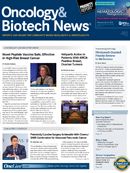Publication
Article
Clonal Hematopoiesis in Normal Individuals Might Represent a New Way to Approach Blood Cancer Risk and Diagnosis
Cancers arise from multiple acquired mutations that presumably occur over many years, as shown in a number of models, particularly in colon cancer.
Andre Goy, MD
Editor-in-Chief of
Oncology & Biotech News
Chairman and Director Lymphoma Division Chief John Theurer Cancer Center at HackensackUMC Chief Science Officer and Director of Research and Innovation Regional Cancer Care Associates Professor of Medicine, Georgetown University
Cancers arise from multiple acquired mutations that presumably occur over many years, as shown in a number of models, particularly in colon cancer.1
A number of “precancer” phenotypes have already been identified in hematology, such as MGUS, CLUS, and MDS— some of them only evolving to true hematological cancers.
Translocations frequently involved in blood cancers, such as the t(14;18) translocation in B-cell lymphomas, are found in about half of the normal population, illustrating the fact that additional alterations are needed to develop lymphoma.2 The number of copies of t(14;18) varies significantly among individuals and increases with age, carrying a yet to be defined (but likely real) risk of developing the disease. The advent of whole genomics approaches, including whole exome sequencing, have highlighted the dauntingly impressive heterogeneity within a given subtype of cancer (eg, there is an average of 200 nonsilent mutations per genome in large cell lymphoma3) and will likely lead to a redefinition of cancer classification,4 as previously mentioned in this column.
Two important papers published last month looked at whole exome sequencing in a large subset of normal individuals. The first series looked at 12,380 normal subjects unselected for cancer or hematologic phenotypes and followed outcomes using Swedish national registries for 2 to 7 years after DNA sampling.5 Somatic mutations consistent with clonal hematopoiesis were observed in 10% of individuals aged >65 years, but in only 1% of those aged <50 years. Clonal hematopoiesis was a strong risk factor for subsequent hematologic cancer (HR = 12.9), and approximately 42% of hematologic cancers in this cohort arose in persons who had clonality at the time of DNA sampling. Analysis of bone marrow in some cases at the time of diagnosis of acute myeloid leukemia revealed that cancers arose from the earlier clones showing abnormalities at the time of “normal individuals” testing.
The second series looked at 17,182 persons focusing on single-nucleotide variants and small insertions or deletions in 160 genes recurrently mutated in hematologic cancers.6 Again, detectable somatic mutations increased with age: rare in those aged <40 years, 9.5% in those aged 70 to 79 years, and 18.4% in those aged ≥90 years. The presence of a somatic mutation was also associated with an increase in risk of hematologic cancer (HR = 11.1), as well as an increase in all-cause mortality, possibly due to an increased risk of cardiovascular disease (though it remains unclear if this was due to confounding variables or a shared consequence of the underlying process of aging).
Overall, both studies showed that somatic mutations that drive clonal expansion of blood cells are a common finding in the elderly and associated with worse outcomes. What is interesting is that the majority of the variants occurred in the same three genes in both series: DNMT3A, TET2, and ASXL1. Though these genes have been implicated in hematologic cancers, they seem to be early initiating events, while known drivers of actually diagnosed hematological entities were typically not found in either series.
Though such mutations theoretically have potential implications for early detection, the absolute risk of conversion from clonal hematopoiesis to hematologic cancer was modest (1.0% per year) and routine screening appears premature at this point.
Once again, the ability to broadly look at the genetic landscape is changing the field in oncology and medicine at large. Hopefully, an improved ability to predict future harm in asymptomatic persons may eventually replace the traditional dichotomy between illness and health.
Future goals would be to identify among a continuum of ascertainable genomic states those that are associated with elevated risk of future illness. Similarly, the next step would be to have the ability to target some of these relevant abnormalities and intervene early. That could become the ultimate genetic counseling answer in individuals who are at risk because of a prior cancer or a known genetic risk factor in their family.
References
- Fearon ER, Vogelstein B. A genetic model for colorectal tumorigenesis. Cell. 1990;61(5):759-767.
- Limpens J, Stad R, Vos C, et al. Lymphoma-associated translocation t(14;18) in blood B cells of normal individuals. Blood. 1995;85(9):2528-2536.
- Morin RD, Mungall K, Pleasance E, et al. Mutational and structural analysis of diffuse large B-cell lymphoma using whole-genome sequencing. Blood. 2013;122(7):1256-1265.
- Hoadley KA, Yau C, Wolf DM, et al. Multiplatform analysis of 12 cancer types reveals molecular classification within and across tissues of origin [published online August 7, 2014]. Cell. 2014;158(4):929-944.
- Genovese G, Kähler AK, Handsaker RE, et al. Clonal hematopoiesis and blood-cancer risk inferred from blood DNA sequence [published online November 26, 2014]. N Engl J Med. doi:10.1056/NEJMoa1409405.
- Jaiswal S, Fontanillas P, Flannick J, et al. Age-related clonal hematopoiesis associated with adverse outcomes [published online November 26, 2014]. N Engl J Med. doi:10.1056/NEJMoa1408617.










